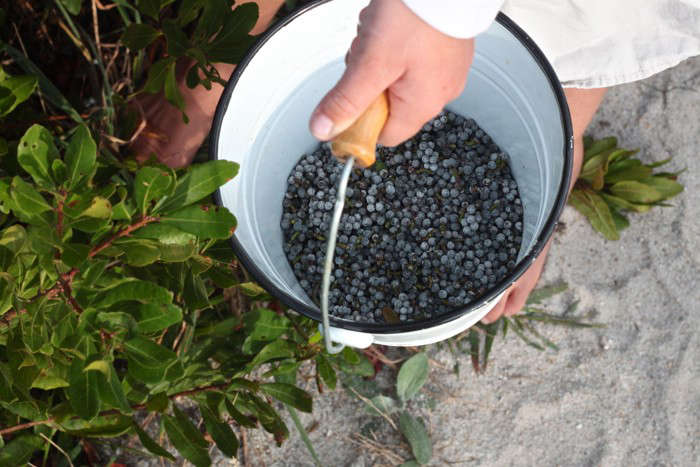Bayberry (Myrica pensylvanica): “The Survivor”
You have to admire the characters in the Swiss Family Robinson who, after being shipwrecked, not only survived but seemed to carve out a pretty decent living, complete with a killer treehouse that kids and adults alike envy. They foraged for food, built all sorts of life-improving contraptions, and even—being lucky enough to crash on an island with bayberry shrubs—lit their evenings with homemade bayberry candles.
While I have no aspirations of being this resourceful—it was fiction, after all—I can still appreciate the idea of making the most of multipurpose plants like Myrica pensylvanica. Even if you’ve never seen bayberry, you’d almost certainly recognize its scent. With a botanical name that’s derived from the Greek word myrike, meaning fragrance, this East Coast native’s essential oils have long been used in soaps and other home goods, and the waxy coating from its berries is still used to make candles.
Above: Photograph by Justine Hand. For more, see The Romance of the Homemade Candle.
Aside from being useful, bayberry also is attractive. Reaching 5 to 10 feet tall and wide, bayberry is perfect for the back of a garden border, where its dense, long leaves provide shelter for the birds that make a buffet of its gray-blue berries. (Note that if you want berries, you’ll need both male and female plants.)
Above: Photograph by Marie Viljoen. For more, see True Colors: 9 Best Shrubs for Fall Foliage.
Green foliage turns bronze in winter, and while this super tough grower prefers regular water and acidic soil, it tolerates salty seaside conditions, poor soil, drought, and wind.
Cheat Sheet
Above: Photograph by Gentl & Hyers. For more, see Garden Visit: A Design Couple’s Shelter Island Retreat.
- Grow it in a spot where its bronze winter leaves will stand out.
- Pairs well in a landscape with evergreens and woodland plants.
- Bayberry’s fragrant leaves, useful for making wax and other crafts.
Keep It Alive
- Bayberry prefers full to part sun and moderate amounts of water.
- Best suited for borders.
- Plant in spring or fall.
Above: Photograph by Justine Hand.
If you’re thinking of making bayberry candles from scratch, Justine writes, “About two pounds into it, I started to realized why colonial women quickly abandoned this practice. It takes from six to eight pounds of berries to make one pound of wax. Thus, being a modern woman with access to online ordering, I decided to cut some colonial corners and combine our bayberry wax with beeswax, which I did not attempt to make myself.”
For Justine’s step-by-step DIY on how to make bayberry candles, see The Romance of the Homemade Candle.
N.B.: If you’re designing a border, see more of our favorite back-of-the-border shrubs in our Garden Design 101: guides:
- You can begin with Shrubs: A Field Guide.
- Looking to add some color, you might want to consider the Hydrangea.
- And, if you’re interested in something with berries, explore Smoke Bush 101, which provides a dramatic backdrop for any garden.












Have a Question or Comment About This Post?
Join the conversation